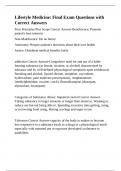Lifestyle Medicine: Final Exam Questions with
Correct Answers
Four Principles Plus Scope Correct Answer-Beneficence: Promote
patient's best interests
Non-Maleficence: Do no harm•
Autonomy: Respect patient's decisions about their own health
Justice: Distribute medical benefits fairly
addiction Correct Answer-Compulsive need for and use of a habit-
forming substance (as heroin, nicotine, or alcohol) characterized by
tolerance and by well-defined physiological symptoms upon withdrawal:
Smoking and alcohol, Opioid (heroin, morphine, oxycodone,
hydrocodone, pain medicine prescriptions), Amphetamines
(methylphenidate, cocaine, crack), Benzodiazepine (diazepam,
alprazolam, lorazepam)
Categories of Substance Abuse: Impaired control Correct Answer-
Taking substance in larger amounts or longer than meant to, Wanting to
reduce use but not being able to, Spending excessive time getting, using,
or recovering from using, Having cravings and urges to use
Tolerance Correct Answer-capacity of the body to endure or become
less responsive to a substance (such as a drug) or a physiological insult
especially with repeated use or exposure developed a tolerance to
painkillers
,Withdrawal Correct Answer-Specific signs and symptoms occurring
after discontinuing the given substance
Dependence Correct Answer-Physiological dependence if the person
shows withdrawal or tolerance; term is not used in the DSM-V -
Substance Use Disorders, instead.
1964-WHO introduced the term dependence to replace "addiction" and
"habituation" Effort to reduce stigmatization of those suffering from this
disease Terminology changed to Substance Use Disorder DSM-V
ABCDE's of Addiction Correct Answer-A - Inability to consistently
Abstain
B - Impairment in Behavioral control
C - Craving; or increased "hunger" for drugs or rewarding experiences
D - Diminished recognition of significant problems with one's behaviors
and interpersonal relationships
E - A dysfunctional Emotional response
Risk Factors for Addiction Correct Answer-Genetic: 50% genetic, Level
of dopamine receptors, Age, gender, ethnicity, co-morbid mental illness
Environmental: Drug availability, Peer pressure, physical abuse, sexual
abuse, witnessing violence Development: The earlier a person begins
using drugs, the more likely addiction will develop, Adolescent brains
are still developing, especially frontal lobe, executive function like
decision making and judgment
, Addictive Substances and DSM-V Correct Answer-Substance Related
and Addictive Disorders:
Tobacco: Tobacco Use Disorder. Alcohol: Alcohol Use Disorders,
Opiates: Opioid Use Disorder, Caffeine: Caffeine-Related Disorder•
Non-substances Related Disorders, Gambling• Conditions for Further
Study, Internet Gaming Disorder• Binge Eating Disorder (New to DSM-
V)
DSM-V: Substance Use Disorder Correct Answer-A pathological set of
behaviors related to the use of a substance (e.g., alcohol, opioids,
stimulants, tobacco, etc.)
11 diagnostic criteria in 4 broader categories: Impaired control, 2-3
criteria; mild, 4-5 criteria; moderate, 6+ criteria; severe
Categories of Substance Abuse: Social Impairment Correct Answer-Not
managing work, family, or social obligations because of use• Continuing
to use even when it causes relationship problems• Giving up important
activities because of use
Categories of Substance Abuse: Risky use Correct Answer-Using in
physically dangerous situations• Using despite awareness it's causing or
worsening physical or psychological problems
Categories of Substance Abuse: Pharmacological indicators Correct
Answer-Tolerance and withdrawal symptoms




